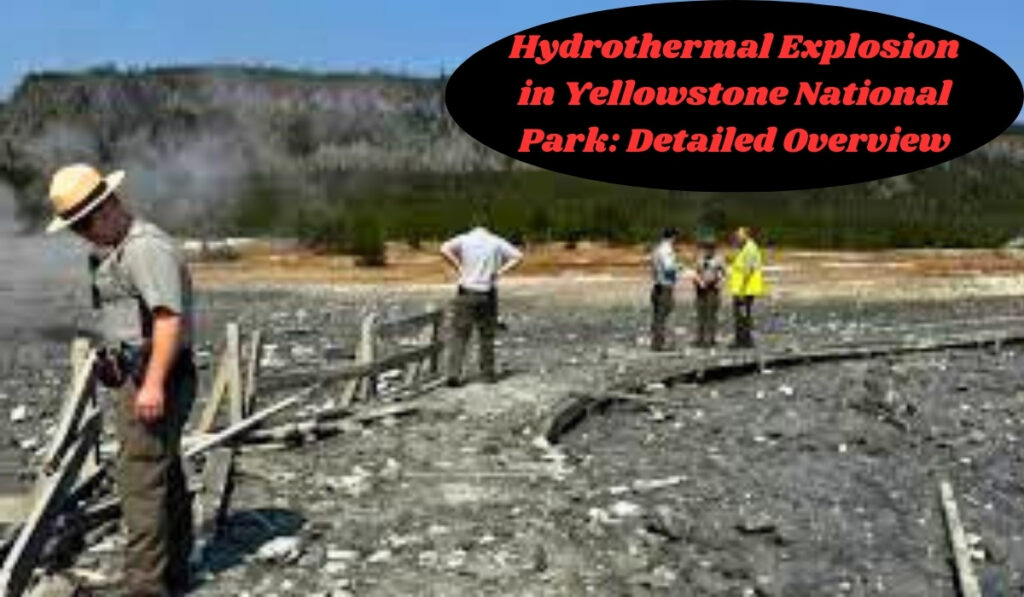Introduction
On Tuesday morning, a hydrothermal explosion occurred in Yellowstone National Park, specifically in the Biscuit Basin area. This explosion, described as “small” by Michael Poland, Scientist-in-Charge at the U.S. Geological Survey’s (USGS) Yellowstone Volcano Observatory, caused notable damage and sent debris high into the air. This article provides a detailed overview of the incident, including its effects, scientific explanations, historical context, and ongoing investigations.
Incident Overview
1. Explosion Details
- Date and Time: The hydrothermal explosion took place around 10 a.m. on Tuesday.
- Location: Biscuit Basin, approximately 2.1 miles northwest of Old Faithful, likely in the Black Diamond Pool area.
- Damage: The explosion damaged a boardwalk and scattered debris several stories into the air.
- Injury Report: According to early statements, no injuries have been reported as a result of the explosion.
2. Immediate Aftermath
- Witness Accounts: Videos shared online showed people on the boardwalk near the explosion site. The footage captured the aftermath, including debris spread across the area and damage to the boardwalk.
- Safety Measures: The parking lot and boardwalks in Biscuit Basin have been temporarily closed for safety reasons.
3. Official Statements
- USGS Comments: Michael Poland reassured that the explosion was considered “small” and not indicative of volcanic activity. The monitoring data indicated no unusual changes in the Yellowstone region’s volcanic system.
- Hydrothermal Explosions: According to Poland, hydrothermal explosions are relatively common in Yellowstone and occur when water rapidly converts to steam underground.
Scientific Background
1. Hydrothermal Explosions Explained
- Process: Hydrothermal explosions occur when pressurized water beneath the Earth’s surface rapidly transforms into steam. This sudden release of pressure can cause violent eruptions, sending steam, water, mud, and rock into the air.
- Frequency: Such explosions are relatively frequent in Yellowstone, though large-scale events are rare.
2. Historical Context
- Past Incidents: A similar explosion occurred in Biscuit Basin in May 2009. Other notable explosions include a smaller event in Norris Geyser Basin on April 15 and the Porkchop Geyser explosion in 1989.
- Impact: Hydrothermal explosions can reach heights of up to 1.2 miles and can cause significant environmental and structural damage.
3. Recent Research
- USGS Report (2018): According to the USGS, large hydrothermal explosions occur approximately every 700 years. At least 25 craters in Yellowstone are over 328 feet wide. The report highlights that while large explosions are rare, the potential for future events remains significant.
- Crater Formation: Historical data suggests that large explosions capable of creating significant craters might occur every few hundred years based on past occurrences over the last 16,000 years.
Specific Area Insights
1. Black Diamond Pool
- Historical Activity: The Black Diamond Pool experienced a notable eruption in July 2006, following an earthquake. It has had several explosive events since then, though eruptions have been infrequent.
- Current Status: The pool’s average temperature is 148.5 degrees Fahrenheit, and it remains a site of interest for monitoring and research.
2. Visitor Safety
- Park Response: The Yellowstone National Park’s public affairs office referred inquiries to the USGS for more detailed information. The park has taken necessary precautions to ensure visitor safety in the affected areas.
Ongoing Investigations
1. Monitoring and Analysis
- Current Status: Yellowstone National Park geologists are investigating the recent explosion. Preliminary data shows no abnormal volcanic activity.
- Future Updates: The Yellowstone Volcano Observatory will release additional information as it becomes available, providing updates on the investigation and any further implications.
2. Public Awareness
- Communication: The park and scientific community are focused on keeping the public informed about any potential risks and the ongoing status of the affected areas.
Conclusion
The hydrothermal explosion in Yellowstone National Park’s Biscuit Basin serves as a reminder of the dynamic and active nature of geothermal features in the park. While the recent event caused notable damage, it is considered a relatively common occurrence within the region. Continued monitoring and research will provide further insights into the implications of such events and help ensure the safety of visitors and the preservation of this unique natural environment.
References:
- U.S. Geological Survey (USGS)
- Yellowstone Volcano Observatory
- National Park Service
This detailed overview aims to provide a comprehensive understanding of the recent hydrothermal explosion, its background, and its implications for Yellowstone National Park.

